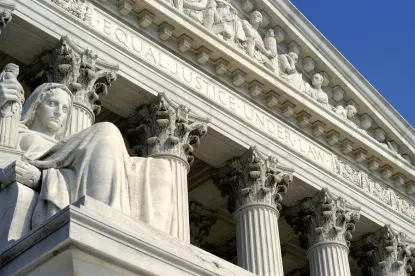1. Summary
Patent law’s assignor estoppel doctrine bars the inventor and those in privity with him or her from challenging the validity during infringement litigation of a patent s/he had assigned. In Minerva Surgical, Inc. v. Hologic, Inc., et al., the Supreme Court limited the doctrine, holding it “applies when, but only when, the assignor’s claim of invalidity contradicts explicit or implicit representations he made in assigning the patent.” The case has implications for those administering a company’s patent protection procedures and in technology company M&A transactions; it also creates issues for the lower courts to resolve in determining whether the doctrine will apply.
2. Background of the Case
The classic case for assignor estoppel begins with an inventor who files and obtains a patent then assigns it to a company for value. Later, the inventor/ assignor founds a new company and develops a competing — and arguably infringing — product. When the first assignee/company sues for infringement, the assignor tries to argue — contrary to the explicit or implicit assurance given in assigning the patent — that the invention was unpatentable and his patent never valid.
In Minerva, inventor Csaba Truckai co-founded a company in 1993 which developed a surgical device for treating a particular condition. The company marketed the device and filed a patent application for the invention in 1998, with Truckai assigning his rights to the company. The company (including the patent rights) was acquired in 2004, Truckai netting about $8 million from the deal and leaving the company. Hologic acquired the successor in 2007 and in 2008 Truckai founded Minerva, where he was President, CEO, and a member of the board. At Minerva, Truckai co-developed a surgical device to treat the same condition using a different technology. In 2013, Hologic filed a continuation of Truckai’s patent application, which was issued in 2015 around the time Minerva obtained FDA approval to market its device. Hologic sued Minerva for infringement in November 2015.
Minerva contended that the claim obtained via the 2013 continuation application was broader than what Truckai co-invented for the 1998 application and argued the claim was invalid for lack of enablement and failure to provide an adequate written description. The District Court ruled, and the Federal Circuit affirmed, that assignor estoppel barred Minerva’s invalidity defenses. Minerva filed an inter partes review (IPR) challenging the patent based on prior art which was not instituted.
Minerva asked the Supreme Court to abandon or narrow the assignor estoppel doctrine. The United States, as invited amicus curiae, argued to limit it to where the assignor (i) sells patent rights for valuable consideration (ii) in an arm’s-length transaction, then either contests the validity of (iii) a claim materially identical to a claim issued or pending at the time of the assignment (or otherwise contradicts pre-assignment representations about the patent’s validity).
3. The Supreme Court’s Minerva Decision
The Court rejected both of those positions, holding that “[t]he doctrine applies when, but only when, the assignor’s claim of invalidity contradicts explicit or implicit representations he made in assigning the patent.” As described more below, the Court gives examples of when a claim of invalidity would not contradict such representations.
The Court reasoned that assignor estoppel should apply “only when its underlying principle of fair dealing comes into play. That principle … demands consistency in representations about a patent’s validity: What creates the unfairness is contradiction. When an assignor warrants that a patent is valid, his later denial of validity breaches norms of equitable dealing.” The “warranty need not be express … the assignment of specific patent claims carries with it an implied assurance” via the inventor’s oath that s/he is “the original inventor” of the “claimed invention,” and the duty to disclose information known to be material to patentability. That is, “[an] inventor presenting an application to the PTO thus states his good-faith belief that his claims … will result in a valid patent … [and] effectively incorporates that assurance” when assigning to another. Conversely, “when the assignor has made neither explicit nor implicit representations in conflict with an invalidity defense, then there is no unfairness in its assertion. And so there is no ground for applying assignor estoppel.”
3.1 The Court’s Examples of Where Estoppel Would Not Apply
The Minerva opinion includes three examples where estoppel would not apply.
The first is “when the assignment occurs before an inventor can possibly make a warranty of validity as to specific patent claims. … An employee assigns to his employer patent rights in any future inventions he develops during his employment; the employer then decides which, if any, of those inventions to patent. In that scenario, the assignment contains no representation that a patent is valid. How could it?”
The second is “when a later legal development renders irrelevant the warranty given at the time of assignment,” such as a change in law “so that previously valid patents become invalid.”
The third is that “a change in patent claims [] can remove the rationale for applying assignor estoppel,” when the assignor “enlarges” the claims beyond what the assignor intended to claim as patentable: “Assuming that the new claims are materially broader than the old claims, the assignor did not warrant to the new claims’ validity. And if he made no such representation, then he can challenge the new claims in litigation: Because there is no inconsistency in his positions, there is no estoppel. The limits of the assignor’s estoppel go only so far as, and not beyond, what he represented in assigning the patent application.”
If Hologic’s new claim is materially broader than the ones Truckai assigned, the Court concluded he could not have warranted its validity in making the assignment, and there is no basis for estoppel.
3.2 Remand and Dissents
The Court vacated the judgment and remanded the case for the Federal Circuit to consider if the claim at issue was materially broader than those the inventor assigned. “Resolution of that issue in light of all relevant evidence will determine whether [the inventor’s] representations in making the assignment conflict with his later invalidity defense — and so will determine whether assignor estoppel applies.”
Justice Amy Coney Barrett (joined by Justices Clarence Thomas and Neil Gorsuch) and Justice Samuel Alito dissented, each finding inadequate basis in law for the doctrine.
4. Implications and Take-aways
The Minerva decision creates legal issues that lower courts will need to address and may change transactional practice with inventors and patent practice.
On remand, the Federal Circuit will need to consider the Court’s “materially broader” claim trigger to avoid application of assignor estoppel. Whether it treats that as a question of law, like claim construction, or in another way will impact the practical application of assignor estoppel in the future. Relatedly, what evidence is relevant to this question will need to be resolved and several disputes on that issue are foreseeable.
Minerva may also have implications for transactional and prosecution practice. Because the doctrine most commonly applies when a departed employee-inventor founds a competing company, businesses seeking to mitigate Minerva’s effects may wish to concentrate remedial measures on their inventors with the greatest likelihood of doing that.
Companies may consider obtaining representations from key inventors confirming their belief in the patentability for current and contemplated claims before departure. Relatedly, in an M&A context, the acquirer may want to consider obtaining such representations from the target’s key inventor-employees before closing.
Conversely, inventors merely consulting for a company or otherwise seeking to reduce the risk of assignor estoppel applying to a later venture may wish to cabin representations about their inventions explicitly.
Often, employees at technology companies will execute an employee invention assignment agreement upon hiring that makes a present assignment of future inventions to the employer. This assignment — the first example Minerva gives where assignor estoppel would not apply — is often joined by a separate specific assignment for each patent application. Diligently following this latter practice takes on greater importance after Minerva, as it may allow invoking assignor estoppel, where the former alone would not.
Employers considering seeking inventor covenants not to challenge their patents or otherwise limit the effects of Minerva should seek advice on the particular provisions being considered, as there could be enforceability issues to evaluate.
Patent prosecutors may also wish to consider filing supplemental declarations after allowance if the final claims could be considered materially broader than those originally filed. Additionally, while there are risks of prosecution history estoppel to balance, prosecutors may wish to consider the breadth of claims to originally file in applications on behalf of an inventor posing a risk to launch a competitor.
Finally, it bears noting that under current Federal Circuit law, assignor estoppel does not bar validity challenges via inter partes review. The Court denied a separate Minerva cert. petition seeking review of a related issue. So, while Minerva may spur some litigation on the point, the Court did not signal interest in that issue, which remains an option for validity challenges in appropriate circumstances.




 />i
/>i

